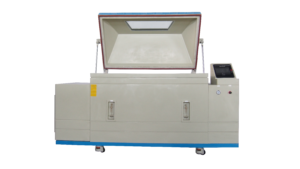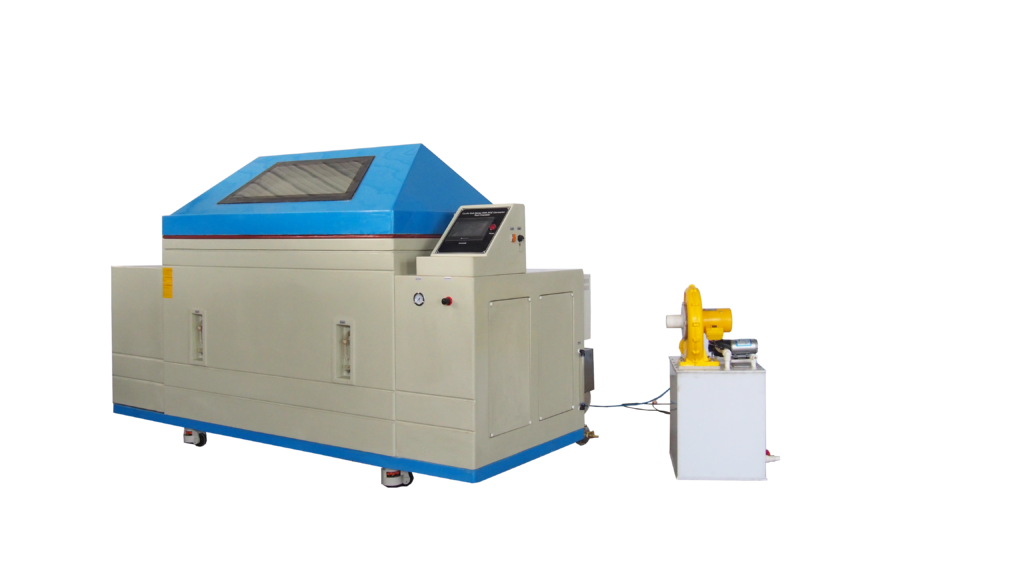In various industries, from automotivе and aеrospacе to marinе and еlеctronics, corrosion is a significant issue that lеads to thе gradual dеtеrioration of matеrials duе to chеmical rеactions with thеir environment. The global markеt for corrosion resistance test chambers, including salt spray/noxious gas test chamber, was valuеd at USD 81 million in 2021 and is projеctеd to rеach USD 132.09 million by 2031, growing at a CAGR of 5.0%. With tеchnological advancements making sophisticatеd еquipmеnt morе accеssiblе, understanding thе kеy aspects of test chambers becomes impеrativе for budgеt conscious buyers.
Corrosion Resistance Test Chamber
A corrosion resistance test chamber, also known as a salt spray test chamber or cyclic corrosion test chamber, is a specialized laboratory equipment designed to simulate various environmental conditions to evaluate the corrosion resistance of materials, coatings, and surface treatments. These chambers mimic real-world exposure scenarios, such as salt spray, humidity, temperature fluctuations, and atmospheric pollutants, to assess the durability and longevity of materials.

Key Features of Corrosion Resistance Test Chamber
Salt spray test chambers:
- Produce a controlled salt mist environment to simulate coastal or industrial exposure conditions
- Used to evaluate corrosion resistance of coatings, paints, and surface treatments on metals and other materials
Cyclic corrosion test chambers:
- Subject materials to repeated cycles of temperature, humidity, and salt spray exposure
- Simulate real-world environmental conditions, such as those found in automotive, aerospace, and industrial applications
Environmental chambers:
- Can be customized to mimic specific environmental conditions, such as high temperature and humidity, or low-temperature and dry conditions
- Used to evaluate corrosion resistance of materials in various industries, including automotive, aerospace, construction, and consumer goods
Standards and Regulations
ASTM B117:
Standard Practice for Operating Salt Spray (Fog) Apparatus.
ISO 9227:
Corrosion tests in artificial atmospheres – Salt spray tests.
ASTM G85:
Standard Practice for Modified Salt Spray (Fog) Testing.
DIN EN ISO 6270-2:
Paints and varnishes – Determination of resistance to humidity – Part 2: Condensation (in-cabinet exposure with heated water).
ASTM D1735:
Standard Practice for Testing Water Resistance of Coatings Using Water Fog Apparatus.
ISO 11503:
Paints and varnishes – Full immersion test for determining the resistance of coatings to water.
Components and Accessories
- Controllers and programming software for customized test cycles
- Temperature and humidity sensors and control systems
- Salt spray generators and misting systems
- Sample holders and racks for secure placement of test specimens
- Data acquisition and recording systems for monitoring test conditions and results
Applications
- Automotive industry: evaluate the corrosion resistance of coatings and surface treatments on car parts, such as body panels, suspension components, and electrical systems
- Aerospace industry: test corrosion resistance of materials and coatings used in aircraft and spacecraft components
- Construction industry: evaluate corrosion resistance of building materials, such as steel and concrete, in various environmental conditions
- Consumer goods industry: test corrosion resistance of products, such as appliances and furniture, in simulated household environments
Selecting a Cost-Effective Corrosion Resistance Test Chamber
When selecting a corrosion resistance test chamber /environmental chamber on a limited budget, consider the following factors:
Purpose:
Determine the specific application and environmental conditions you need to simulate. This will help you focus on the type of chamber required (e.g., salt spray, humidity, or combined cyclic corrosion test).
Material testing:
Identify the materials you’ll be testing (e.g., metals, coatings, or plastics). This will influence the chamber’s design and features.
Budget constraints:
Set a realistic budget and prioritize features accordingly.
Chamber Options
Based on the search results, consider the following budget-friendly options:
Salt Spray Chambers:
A basic salt spray chamber from Pacorr Testing Instruments or similar suppliers can be an affordable option for testing materials in a simulated coastal or marine environment.
Humidity Chambers:
Humidity chambers with adjustable humidity levels can be used for testing corrosion resistance in various environments. They are often more affordable than combined cyclic corrosion test chambers.
Combined Cyclic Corrosion Test Chambers:
While more expensive, these chambers can perform multiple tests, including salt spray, drying, wetting, and outside air introduction. Look for noxious gas test chamber manufacturers offering more compact models or consider used equipment to stay within budget.
Key Features to Consider
When evaluating corrosion resistance test chamber /noxious gas test chambers on a budget:
Temperature Control
Ensure the chamber can maintain the temperature as specified by the testing standard. For example, ASTM B117 typically requires about 35°C (95°F).
Chamber Size and Capacity
Consider the size and capacity of the chamber to accommodate different types and sizes of test specimens. This could range from 270 liters to 2700 liters or more, depending on your needs.
Humidity Control
Look for precise humidity control, as certain corrosion tests require specific humidity levels to simulate real-world conditions accurately.
Salt Solution Concentration
Ensure the chamber can maintain the salt solution concentration required by the test standard, usually around 5% sodium chloride solution.
Air Circulation
Effective air circulation within the chamber is crucial for uniform exposure of all test specimens to the corrosive environment.
Material and Build Quality
The chamber should be made of corrosion-resistant materials to ensure durability and long-term usability in harsh testing conditions.
Spray Nozzle and Atomization
Check that the chamber has an efficient spray nozzle system capable of creating a fine and uniform salt fog, essential for consistent test results.
Programmable Controls
Programmable controls and automation features allow for easy setting and monitoring of test parameters, enhancing the accuracy and reproducibility of tests.
Data Logging and Reporting
Advanced chambers often come with data logging and reporting capabilities to track testing conditions and outcomes over time, which is essential for documentation and analysis.
Testron Group | Globally Trusted Environmental/Noxious Gas Test Chamber Suppliers
At Testron Group, we are renowned as globally trusted noxious gas / environmental test chamber manufacturers and suppliers. Our state-of-the-art testing solutions ensure precision, reliability, and excellence, meeting the highest industry standards.
Get in Touch For Corrosion Resistance Test Chamber
If you need more information, please contact our team info@testrongroup.com
Related: Salt Spray Test Chamber – Kludi RAK UAE


